Co-founder Tan Hooi Ling to step down from her operating roles at Grab by end 2023

Grab announced today (May 25) that Tan Hooi Ling has informed its board of directors of her intention to step down from her operating roles at Grab, including her directorship, by the end of 2023.
Moving forward, Tan will be transitioning into an advisory role with Grab.
Tan co-founded Grab with Anthony Tan, Group CEO, in 2012 and worked at other companies in the US before rejoining Grab in April 2015. She led various operations and technology teams as the Chief Operating Officer (COO) until January 2022.
Currently, she leads Grab’s technology organisation, and is mentoring the next-generation of technology leaders. Tan has also served as a member of Grab’s Board of Directors since its public listing in December 2021.

“I have enormous respect and love for Ling, as both a business partner and a good friend. We set the vision to build a double, now triple, bottomline company together, and I am so blessed to have found a true partner who cares deeply about the impact we create for Grabbers, our partners and our region,” said Anthony Tan, Group CEO and co-founder of Grab in a media statement.
“Ling has invested herself fully into setting up the right leadership bench and cultural foundations for Grab to thrive for the long-term, and while I will miss working with her dearly, I thank her for the many years of trust and partnership, and wholeheartedly support her decision to pursue her personal passions.”
Tan described Grab as “one of the most fulfilling experiences” of her life and is proud of the impact that they have created together as a team, seeing that it helps to improve lives in Southeast Asia.
“People who know me well know that I am an adventurer at heart, and there are many other personal passions that I have put aside to build Grab with Anthony. With the strong leadership bench we currently have, I believe now is the right time for me to pass on the baton to our next generation of leaders, and to pursue these other passions.”
According to the company, the Nominating Committee of the Board will be reviewing potential candidates to supplement the Board later this year. Grab will make a further announcement upon the changes to its Board of Directors taking effect.
Featured Image Credit: Grab
Also Read: Meet Tan Hooi Ling, the quiet co-founder of Grab who seeded the multi-billion business idea
The saga continues: honestbee still owes S$319.9 million to former staff, vendors, creditors
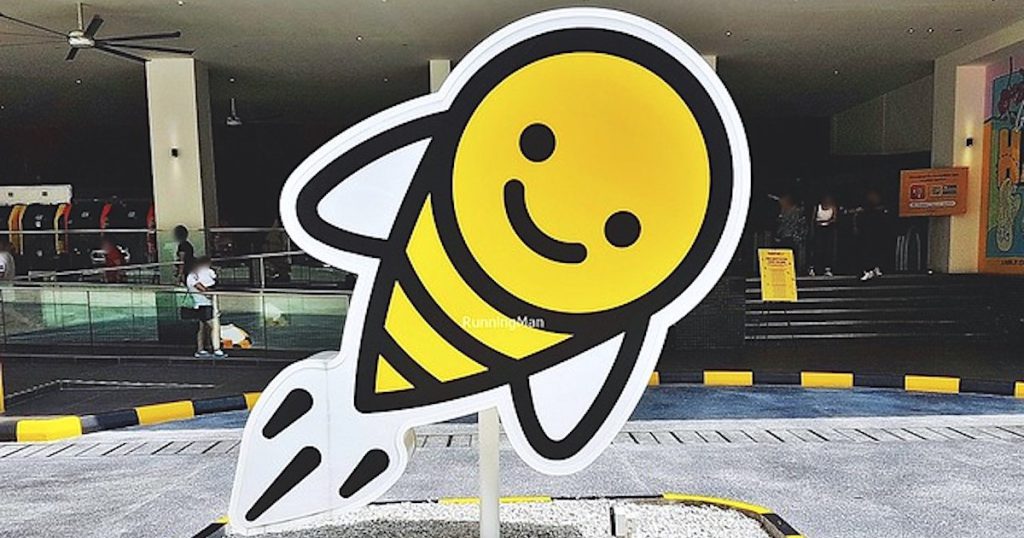
Failed grocery delivery startup honestbee has no funds available to settle outstanding debts to former staff, vendors, and other unsecured creditors, amounting to S$319.9 million, according to The Business Times.
The company’s sole secured creditor, Formation Group, has reportedly recovered approximately S$700,000 from the assets of honestbee, a far cry from the US$4 million worth of debentures held by the venture capital. Numerous former employees of honestbee are also still awaiting unpaid salaries.
Documents reviewed by The Business Times revealed that BDO, the liquidator appointed for honestbee, was only able to recover around S$720 from excess payments related to “electrical supplies.”
Following a creditors’ meeting on May 18, BDO is planning to seek approval from the High Court to discharge itself from its responsibilities and dissolve honestbee.
A recap of the honestbee saga
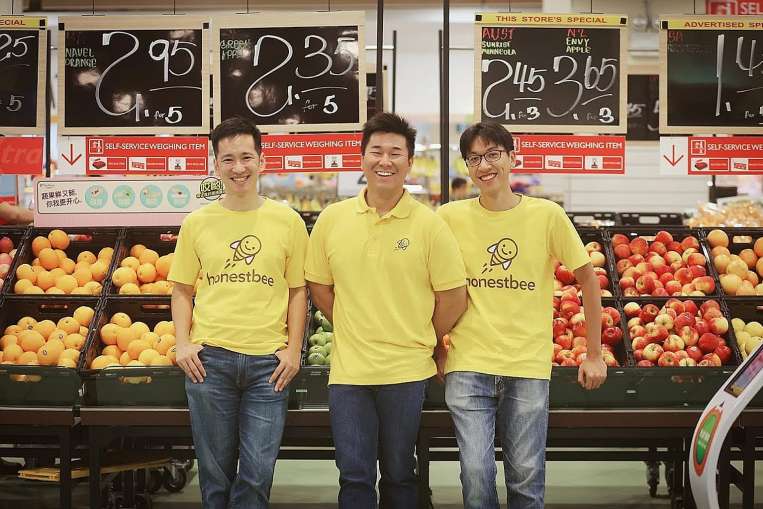
Founded in 2015 by three Singaporean entrepreneurs — Joel Sng, Isaac Tay, and Jonathan Low — honestbee quickly gained momentum as an e-grocer. Over the years, it expanded beyond grocery delivery services to offer other services such as food delivery and laundry services.
The company experienced remarkable success within months of its operation and had successfully established a presence in eight countries across Asia, including Taiwan and Japan.
However, honestbee’s fortunes took a downturn in 2019, leading to its eventual downfall. The company faced a financial crisis, due to poor capital management by its co-founder and CEO at the time, Joel Sng.
Joel treated company funds as his own, making lavish purchases, including a property in Japan which was worth about US$1.1 million. He went on to create multiple shell companies, which he then directed honestbee to make payments to these entities in exchange for their products, all while keeping these transactions undisclosed to investors.
Joel was ultimately ousted from his position as the company grappled to maintain its stability. In the wake of his departure, Ong Lay Ann assumed the role of CEO and embarked on a series of strategic measures to reorganise the company, aiming to breathe new life into the business.
Among these initiatives was the introduction of a pizza joint. However, these attempts proved futile as the company was ultimately placed under liquidation in July 2020.
In May last year, former CEO Joel has been made a bankrupt when he was served with a bankruptcy order by the Singapore court.
Featured Image Credit: Ivan The – Running Man
Also Read: Terraform Labs, Zilingo, honestbee: How poor leadership caused these companies to crash
How this S’pore AI startup is transforming the marketing sector by automating content creation

ChatGPT set the tech world ablaze last November and since then, the generative AI train has shown no signs of slowing down. From writing verses to creating album art, AI tools are proving their use across all areas of the creative process.
While there are still hiccups to address – for example, ChatGPT being repetitive in its descriptions or Midjourney struggling to draw fingers (every artist’s nightmare!) – one thing’s for certain: AI is more than just a viral trend. In fact, it has been around for a lot longer than many realise.
“On its own, ChatGPT wasn’t a huge leap in technology,” says Joshua Wong, co-founder of Singapore-based startup Hypotenuse AI. Wong adds that companies like Hypotenuse – which was founded in 2020 – have long had AI tools which are just as capable.
What set ChatGPT apart wasn’t its technology, but its business model. “They built their [AI] into a chat interface for the layperson, which was easy enough for anyone to use.”
On top of this, ChatGPT was free-to-use at launch. This level of accessibility allowed the chatbot to go viral, in turn spurring the AI trend which all of big tech wants a part of today.
“[ChatGPT] educated the entire world of how capable AI has become,” Wong adds. “Naturally, businesses started to look for tools of similar capability but specialised for their company’s functions, such as marketing.”
Creating Hypotenuse AI
Wong first identified the use for AI in marketing while helping a colleague launch an e-commerce website. “For us, the most frustrating part about this process was writing product descriptions and marketing copy.”
Given his background in machine learning, he set out to automate the process using AI models. “While it was a challenging problem, it was possible to solve.”
Wong began speaking to other companies and soon realised that he wasn’t the only one looking for such a solution. He left his job as an applied research scientist at Amazon and began working on Hypotenuse AI.

Built to fit into the marketing workflow, Hypotenuse can create content – such as articles and descriptions – using a set of keywords. It can learn a brand’s tone of voice and create copy tailored to that as well.
For enterprises, we train bespoke AI models on their past content. Everything we generate matches their style of writing, rather than sounding generic.
– Joshua Wong, co-founder of Hypotenuse AI
Beyond this, Hypotenuse also has access to real-time data. While most AI models are only trained on data up to 2021, Hypotenuse can write factually accurate content with references to current affairs as well.
Will it take over writing roles?

With the ability to draft 2,000-word articles at the click of a button, it’s a wonder if Hypotenuse will leave copywriters out of a job. Wong believes that the technology isn’t quite there yet, but adds that it’ll definitely alter their scope of work.
Copywriters might find themselves spending less time on first drafts and more time on editing and fine-tuning. “AI could make marketers 10 times more efficient,” he remarks.
I see AI as more of an assistant to copywriters – rather than a full replacement – that can accelerate how quickly they create high-quality content. That said, it does change their role to one where they’re collaborating and writing together with AI.
– Joshua Wong, co-founder of Hypotenuse AI
From his own experience working with clients, Wong shares that they’ve trained many teams to use Hypotenuse as part of their writing process. “They are now able to double the amount of content that can be produced.”
On this note, Wong foresees that using AI might soon become a necessity for copywriters, especially those working in fast-paced and trend-driven environments. As the rate of content creation speeds up, it’d become impossible for writers to do all of their work manually.
The future of generative AI
Hypotenuse has benefited significantly from the launch of ChatGPT and rising interest in generative AI.
Since the start of 2023, we have more than doubled the number of active users on our platform. Today, we get over 3,000 new sign-ups a day, with no signs that public interest will wane anytime soon.
– Joshua Wong, co-founder of Hypotenuse AI
This interest is met with an equally high pace at which the technology is developing. With a surge in investments over the past few months, new innovations are becoming a constant in this field.
“It isn’t going to slow down anytime soon either. From an AI research perspective, the discoveries in the past few years have given us many promising directions which haven’t even been fully explored yet,” he adds.

That being said, there are ethical concerns to be mindful of. For example, AI technology evolving too fast for regulators to keep up with. “There is a non-zero chance that AI is the most destructive thing that humanity has ever created,” Wong says. Advanced AI systems can be tough to interpret and control, and if left in charge of critical systems, they could cause a great deal of harm.
On a smaller scale, the ill effects of AI are already visible. The scope for misinformation has widened – just this week, the US stock market took a hit because of an AI-generated image of an explosion at the Pentagon. Deepfakes are becoming prevalent and telling them apart from real visuals is becoming increasingly difficult.
For better or for worse, the pursuit of AI rages on and there’s a lot more yet to come. “There are stronger models that we know of in the research field that haven’t even been released publicly yet. We’re only just scratching the surface on what’s possible with AI.”
Featured Image Credit: Hypotenuse AI
Also Read: AI regulation: Why it’s important and how are S’pore and other countries dealing with it?
What the US’ crackdown on crypto means for Singapore and the rest of Asia

Once a controversial subject, the need to regulate crypto is no longer a topic of debate. As it turns out, the ‘wild west’ of finance – romantic as it sounds – isn’t a place where people want to keep their money. The latest crypto winter has propelled a shift in mindset, and the search for innovation has now turned into a search for trust.
After all, ideas of financial inclusion, tokenisation, and ungodly interest don’t mean much when the company offering them could vanish overnight. Since the LUNA / USDT crash and the subsequent domino of falling crypto firms, regulators have been called upon for their oversight. Investors are looking for a stamp of approval before handing over their money, and sponsoring a large stadium or sports event is no longer enough.
Globally, a number of policymakers have answered this call — in fact, some of them started work before the phone even rang.
Crypto regimes around the world
Starting with Singapore, the Monetary Authority of Singapore (MAS) has addressed payment services involving crypto under the Payment Services Act.
Service providers including Revolut and Coinhako are licensed in the city-state, allowing investors easy access to a wide range of cryptocurrencies. The MAS has discouraged retail investments in this asset class – due to the high volatility and lack of understanding – however, no measures have been taken against it.
Dubai has emerged as a promising crypto hub as well, following the set-up of the Virtual Assets Regulatory Authority (VARA). It’s the first jurisdiction to set up an independent body solely for the regulation of virtual assets.
Binance GM Alex Chehade praised this move stating that it reduces the complexity which arises when crypto is placed under the purview of existing regulatory bodies. Also in the UAE, Abu Dhabi has taken on a progressive outlook regulating crypto assets and associated businesses.

The European Union took a big leap forward this May by adopting a legal framework on markets in crypto assets (MiCA). With rules covering utility tokens, stablecoins, and asset referenced tokens, MiCA aims to protect investors, while still allowing innovation in blockchain and crypto. Coinbase and Binance both commented in support, displaying a willingness to comply and grow in the region.
Finally, Hong Kong has thrown its name into the hat more recently in a bid to become a global crypto hub as well. Earlier in May, its Securities and Futures Commission (SFC) announced that it would allow the retail trading of cryptocurrencies with a large market cap and high liquidity. This includes blue-chip coins such as Bitcoin and Ethereum.
Where is the US headed?
Although it’s a key region for crypto mining and investment, the US hasn’t looked upon crypto companies too kindly in recent times.
Market regulators such as the Securities and Exchange Commission (SEC) have strengthened their efforts since 2022, but they haven’t yet offered the clarity that crypto companies are looking for.
Most notably, the SEC has been embroiled in a lawsuit with crypto firm Ripple Labs, the outcome of which could lay down the future of crypto in the US. The SEC argues that Ripple’s XRP crypto token constitutes an unregistered security offering and thus breaches existing securities laws. If the SEC were to win, it could open the floodgates for similar action against a host of other companies which have issued their own crypto tokens.
This stance was further supported by a leaked memo said to have circulated among members of the Democratic House’s financial services committee. As per the memo, lawmakers have been told to stick to the view that most cryptocurrencies constitute securities and are non-compliant with existing laws.
Apart from this, reports have also emerged of US regulators pressuring banks to cut ties with crypto firms. Without a place to store fiat currency, crypto exchanges would no longer be able to offer their services in the country. This appears to be a response to the FTX collapse and a way to protect consumers from bad actors in the crypto space.
In April, the CEO of Coinbase – the largest crypto exchange in the US – indicated that the company could leave the country in the absence of regulatory clarity.
How will this impact crypto in Singapore?
As US crypto companies prepare their emergency exit plans, global crypto hubs see the opportunity to attract new talent and investment. Two years ago, Singapore may have been a clear-cut first pick, but the competition has grown a lot stronger today.
Countries have become more nuanced with their crypto ambitions and offer different value propositions to companies on the move.

Under the MAS’ regime, utility is the top priority. Blockchain and crypto innovation is looked upon favourably only when it adds value to the real world.
One such example is the application of tokenisation and cross-border remittance, areas in which MAS actively participates. These initiatives aim to address current challenges by leveraging novel technologies. Companies engaged in such services can expect a well-defined trajectory for expansion while operating within Singapore.
On the other hand, retail exchanges and crypto trading firms might not find the country quite as hospitable. For over a year, advertising such services to the general public has been banned. Given the prevailing sentiment, new measures curbing retail trading wouldn’t come as a surprise either.
Beyond this – judging by the number of successful applicants – the crypto licensing requirements in Singapore are stricter than those offered by jurisdictions in the Middle East. Successful applicants are also obliged to follow the prescribed rules even while operating abroad.
Over the years, Singapore has made its vision for the future of crypto abundantly clear – a vision which may soon be pushed forward by companies previously based in the US.
Featured Image Credit: NewsBTC
Also Read: Binance GM talks about the crypto exchange’s return to S’pore as it works with local regulators
180 outlets and over S$100M turnover: Scanteak CEO on reviving her dad’s furniture business
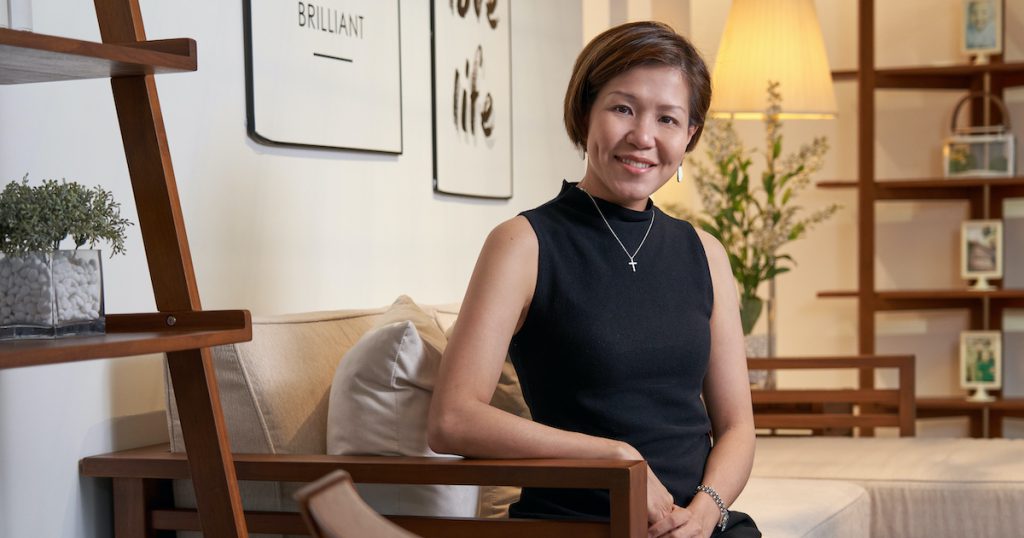
Scanteak, a renowned homegrown furniture brand known for its premium designs and impeccable quality, has a humble origin story with roots that trace back to a rag-to-riches tale.
Despite being a bright child, founder Lim Pok Chin lacked financial resources that hindered his educational aspirations. This prompted him to pursue business as a means to create opportunities for himself.
In the early days, he took on various menial jobs, such as being a coffee boy, carpenter’s apprentice, and a house painter. Despite the hardships, his entrepreneurial spirit remained unwavering.
The foundation of Scanteak began in 1974 with Hawaii Interior Decorations, which specialised in painting houses. His wife was his first employee and with only a modest 400 square feet office space in Joo Chiat, the company expanded rapidly, establishing two showrooms within just two years.
Although Pok Chin had a Chinese education and upbringing, he recognised the power of branding and aimed for an English-sounding company name. Inspired by the popular TV show “Hawaii Five-O,” he named the company Hawaii Interior Decorations.
However, driven by a desire to explore new avenues, Pok Chin ventured into the furniture trade, which deals with the import, export and retail of furniture. In 1979, Hawaii Furnishings was incorporated, achieving an impressive annual turnover of S$10 million within five years.
Unfortunately, the ASEAN financial crisis posed severe challenges, pushing the business to the brink of bankruptcy. The fluctuating currency rates led to a substantial increase in the cost of imported goods, making it almost impossible to sell them at profitable prices.
In those darkest moments, a glimmer of hope emerged as Pok Chin, with help from his friends, decided to “restart” the business. That was how Scanteak was born, out of a crisis, in 1988.
Inspiring family moments with quality and sustainability
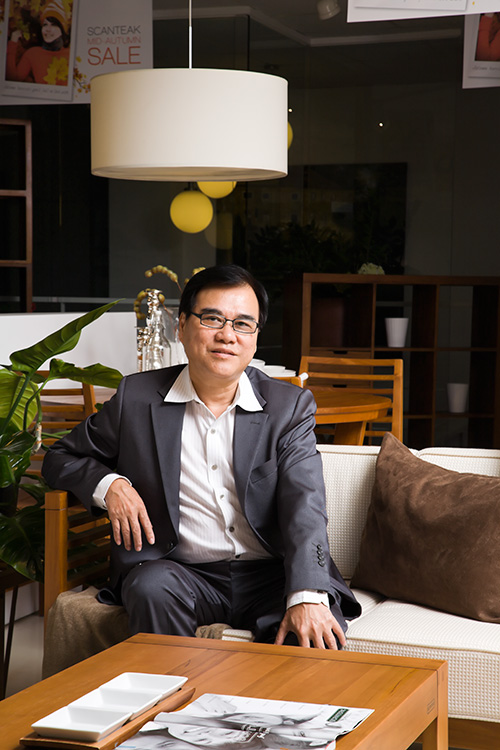
Pok Chin’s visionary approach led him to incorporate Scandinavian minimalist design philosophies with high-quality teak wood sourced from Southeast Asia. This fusion resulted in Scandinavian designed teak furniture, giving birth to the name ‘Scanteak’.
Scanteak’s mission to excel in home furnishings while maintaining a global presence is driven by their vision of “inspiring family moments worldwide”.
In an interview with Vulcan Post, Jamie Lim, CEO of Scanteak, emphasises their goal of creating furniture that is not only functional, but also fuss-free. For example, Scanteak’s removable sofa covers make it easy to clean up spills, enabling families to enjoy their time together without worrying about potential messes. This commitment to enhancing family experiences aligns perfectly with Scanteak’s overarching vision.
When asked to describe Scanteak in one word, Jamie promptly responds with “quality”. Their furniture are designed in Singapore, often in collaboration with designers, and their materials are carefully chosen for their ease of use, durability, and strength. Their ultimate objective is to fulfil customer satisfaction by offering furniture that is built to last a lifetime.
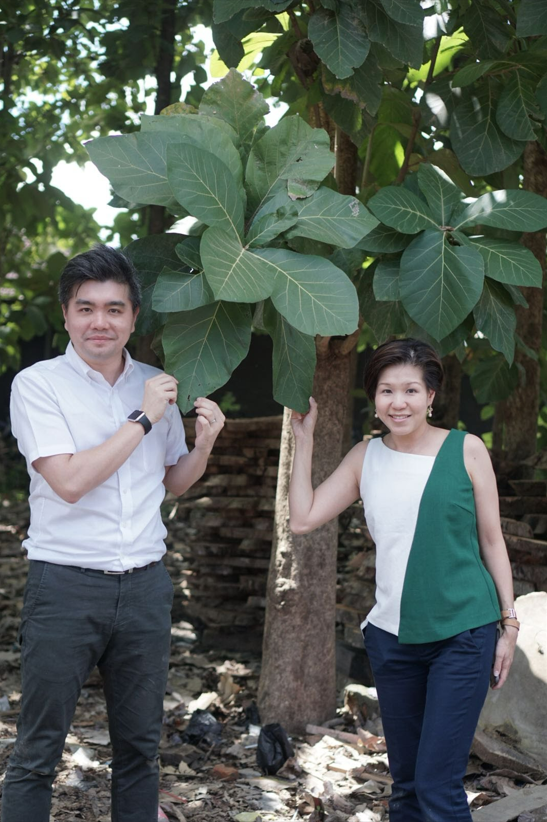
She added that sustainability is a key pillar of Scanteak’s ethos. For starters, Scanteak’s plantations are strictly regulated by the Indonesian government, under the supervision of the SVLK, the national authority for timber legality. This means that their trees are responsibly harvested to ensure sustainability.
The company has also taken proactive steps to ensure compliance with formaldehyde regulations in various countries, such as Japan and Taiwan. Formaldehyde, known to irritate the eyes and sensitive skin, poses potential health risks, including certain cancer-causing properties.
In Singapore, it is not required for furnitures to be formaldehyde-compliant but after a conversation with her brother, Jamie realised the importance of consistency and the impact it would have on future generations.
The siblings ultimately made the difficult decision to require compliance across all markets, even if it meant parting ways with long-time “uncle” suppliers. This commitment to providing safe and sustainable furniture stems from their dedication to inspiring family moments and ensuring the well-being of customers and their children.
Scanteak’s sustainability efforts also extend to their manufacturing processes. “Cost savings and sustainability must go hand in hand,” stressed Jamie.
By designing furniture that maximises the use of materials, Scanteak minimises waste and promotes economic sustainability. For instance, they design a range of furniture pieces, from large planks like sofas to smaller accessories like stools, to fully utilise the available wood without unnecessary wastage.
While balancing inventory levels can be challenging, Scanteak is actively adopting artificial intelligence (AI) to improve forecasting accuracy. They are developing a demand-supply forecast system that utilises AI and machine learning algorithms to analyse historical data, supplier information, lead times, and customer demand. “It basically tells us what to sell and when to sell,” she quipped.
This data-driven approach will enhance inventory management and optimise pricing strategies, ensuring Scanteak meets customer needs efficiently and sustainably.
From Hollywood to teak wood
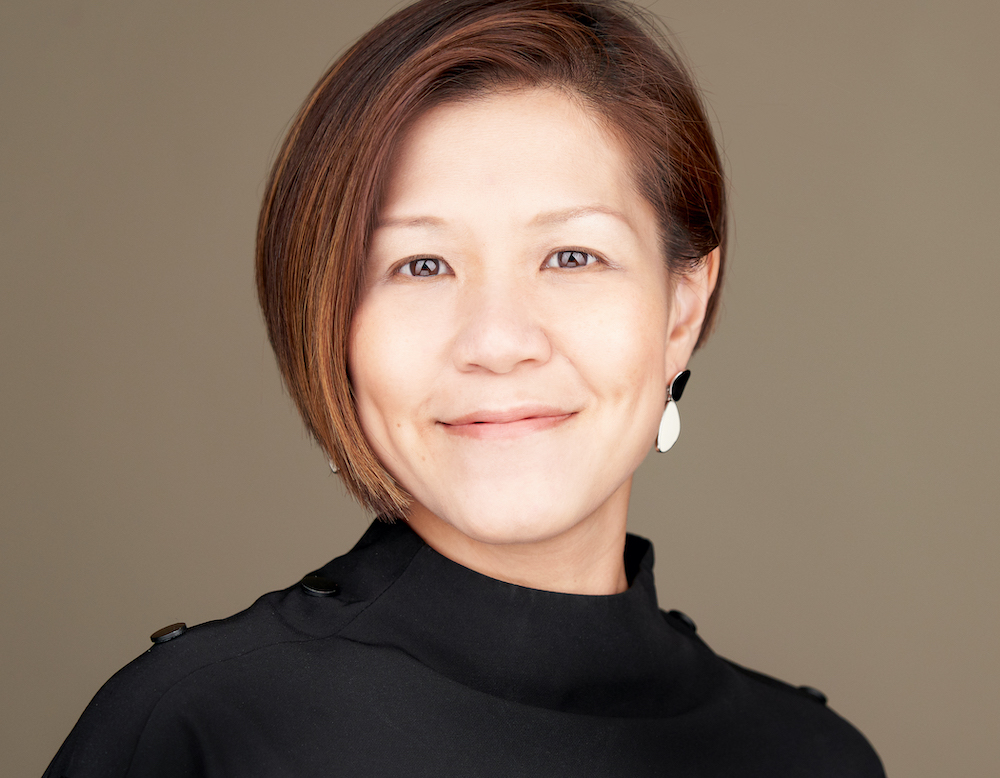
Jamie, the daughter of founder Pok Chin, first joined Scanteak as a regional marketing director in 2004, when she was just in her early twenties.
Before joining Scanteak, Jamie pursued a double major in film and marketing, driven by her desire to make a meaningful impact in this world. Her passion for movies led her to explore a career in Hollywood, where she engaged in both the creation and marketing of films.
After spending two years in Los Angeles, Jamie came to realise that business could also serve as a vehicle for creating an impact.
The catalyst for Jamie’s return to Singapore and her subsequent decision to join Scanteak was an unexpected phone call from her father.
He “accidentally” called me in the US after seven years and he claimed that it was a ‘butt call’. Those were the days of Sony Ericsson and to call internationally, it’s not a WhatsApp call away — you have to dial very long numbers.
So when he called me, he invited me to Taiwan and [painted] me a lavish picture of what a successful business person would look like — and it involved helping employees, embracing customers, and spending quality time with family. And I think I was quite sold on those ideas.
– Jamie Lim, CEO of Scanteak Singapore
This enticing vision, coupled with the allure of becoming part of a grand legacy, ultimately convinced Jamie to take the leap and join Scanteak.
Growing up however, Jamie admitted that she never had the intention to join the family business, so joining Scanteak was a significant step for her.
While there were moments over the past 19 years when she contemplated leaving, she is now grateful for staying because remaining at Scanteak has allowed her to contribute to the family legacy and witness the brand’s growth firsthand.
Harnessing the power of branding
When Jamie joined Scanteak, the brand was actually facing a challenging phase with only three stores remaining in Singapore. In its prime, prior to Jamie’s involvement, Scanteak boasted an impressive network of more than 10 stores across the country.
Recognising the limitations of the Singapore market, her father set his sights on expanding within a “six-hour radius”, inspired by Prime Minister Lee Hsien Loong’s advice to focus on nearby markets.
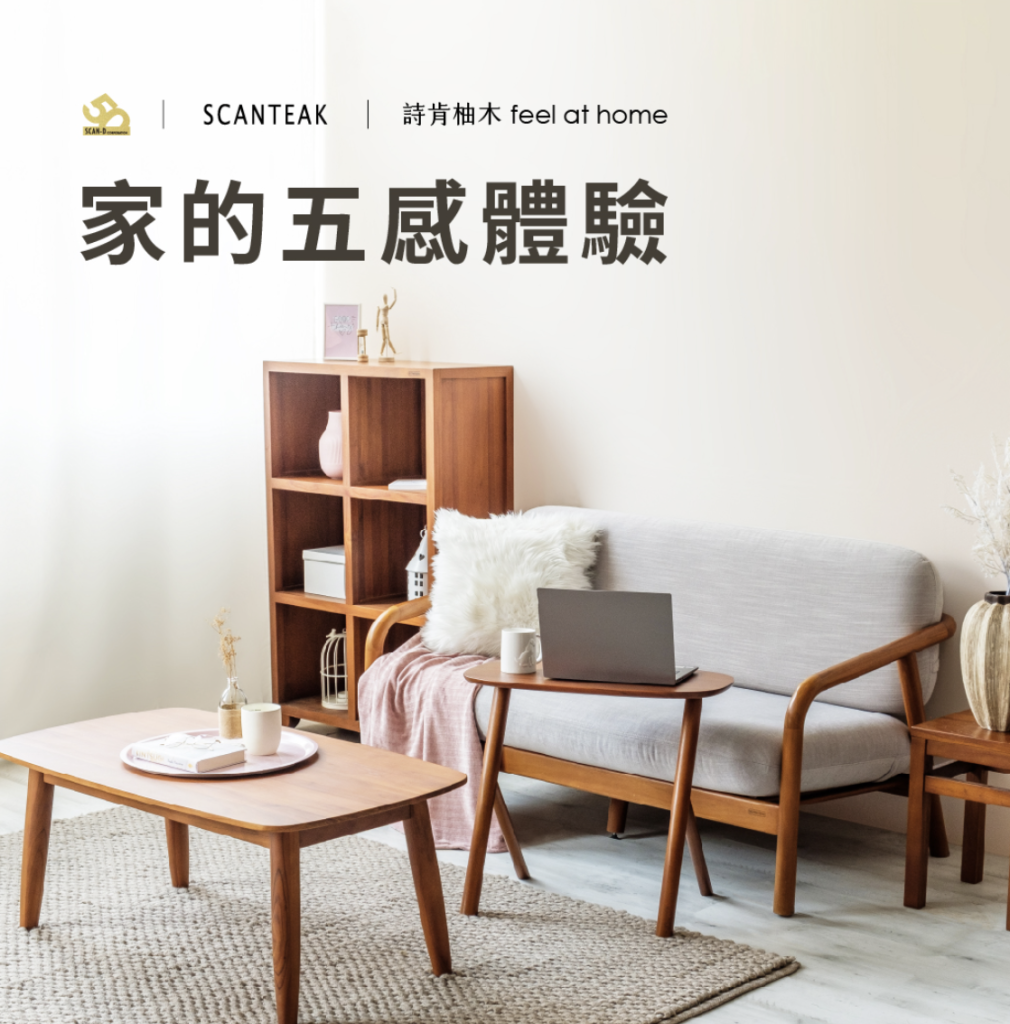
Believing that Taiwan, with its proximity and Chinese-speaking population, presented a valuable opportunity, Scanteak ventured there as its first overseas market. Scanteak experienced steady growth in Taiwan, establishing a presence in the country by 1993 with an annual turnover of S$5 million.
In 2004, Scanteak expanded its reach in Taiwan to 25 showrooms and entered Osaka, Japan. The following year marked the opening of Scanteak’s first flagship store in Taiwan, and by 2010, the brand achieved a significant milestone of surpassing 100 showrooms worldwide.
Following Scanteak’s rapid expansion, Jamie decided to embark on a comprehensive rebranding journey to better reflect the evolving preferences and aspirations of Scanteak’s target audience.

The original tagline, “timeless beauty and quality,” was replaced with the more relatable and inviting tagline, “feel at home.” This shift aimed to establish a stronger emotional connection with customers, emphasising Scanteak’s commitment to creating an environment where people can truly feel at ease and comfortable.
In addition to the tagline change, Jamie revamped Scanteak’s corporate image, including its font and overall visual identity. Jamie also made crucial design alterations to the furniture itself, recognising the varying tastes and lifestyles in different markets.
While Taiwan favoured a more robust and bulky look, Singapore’s growing affluence and modernisation called for slimmer profiles and a more contemporary aesthetic. By adapting the furniture design to suit the preferences of each market, Scanteak successfully appealed to a broader customer base.
Leveraging her marketing expertise, Jamie also created Scanteak’s first TV commercial. This commercial, centred around the heartfelt story of a father and son, won accolades and viewers’ choice awards alongside renowned brands like McDonald’s and Singapore Airlines.
It marked the initial step in Scanteak’s rebranding journey, as the commercial stood out from conventional furniture advertisements. Translating it to Chinese, Jamie brought the commercial to Taiwan, where Scanteak’s branding journey gained momentum.
Jamie added that the media and advertising landscape has dramatically evolved over the years. During Scanteak’s early days, digital advertising was non-existent and people relied on traditional media instead.
Placing an advertisement in a newspaper was a costly endeavour, prompting businesses to pack as much information as possible to maximise the return on investment.
However, her dad’s mentor introduced a refreshing perspective: “less is more” when it comes to strategic branding. Instead of overwhelming potential customers with information, they learnt to create impactful advertisements with minimal content.
By featuring captivating visuals and compelling copywriting, Scanteak’s advertisements stood out from the crowd. The result? Lines formed outside Scanteak stores even before they opened, solidifying the importance of strategic branding in the company’s success.
Embracing digital innovation

Recognising the untapped potential of e-commerce, Scanteak boldly ventured into online retail at a time when the market has yet to embrace this channel fully.
Initially, Jamie’s father harboured reservations about selling furniture online, believing that customers needed to physically experience the comfort and quality before committing to a purchase. However, Jamie keenly observed the market shifting towards e-commerce and proactively secured a grant to launch Scanteak’s online presence.
As a trusted brand known for its distinctive furniture designs, Scanteak’s online strategy centred on showcasing the products in a visually appealing manner.
Jamie noted that while customers may not be familiar with the specifications, size, or colour variations of Scanteak furniture, they generally recognised its overall aesthetic and quality. By featuring the products online, Scanteak saved customers the time and effort of visiting a physical store, catering to their busy lifestyles.
The advent of the COVID-19 pandemic presented significant challenges to businesses worldwide, but Scanteak perceived it as an opportunity to further innovate digitally and develop new solutions. One key initiative involved establishing overseas subsidiaries.
The abrupt implementation of Movement Control Orders (MCO) forced many Malaysian staff members to hastily return to their home countries, potentially leading to a loss of valuable talent. In response, Scanteak set up makeshift offices equipped with Scanteak tables and chairs, enabling employees to work remotely.
Customer service was another area that underwent a significant transformation during the pandemic. With physical stores forced to close, Scanteak had to find alternative ways to maintain seamless communication with customers.
By digitising customer service, Scanteak leveraged its existing business knowledge database and engaged live agents who could address customer queries through online chat platforms. This approach not only ensured prompt and efficient customer support, but also demonstrated that superior service could be delivered without relying solely on phone conversations.
Supply chain disruptions posed yet another challenge for Scanteak during the pandemic. With some suppliers unable to fulfil orders due to unforeseen circumstances, Scanteak had to resort to innovative solutions. The brand independently sourced tabletops and table legs and assembled them in-house, displaying agility and adaptability to meet customer demand.
In addition, their expansion plans into Malaysia and other regions where they had set up warehouses faced significant disruption as a result of the COVID-19 pandemic.
My team of 10 staff members, including individuals from HR, accounting, marketing, design and procurement, were stuck there. I had everybody [from different roles] there, so I thought why not go on Lazada Malaysia and Shopee Malaysia. We also decided to set up a website during the whole COVID period to expand our [presence] since we can’t physically be there.
– Jamie Lim, CEO of Scanteak Singapore
The brand’s online platform experienced significant growth and became its “bread and butter” during the lockdown period. This strategic move is also expected to pave the way for Scanteak’s physical expansion, which it aims to achieve in the fourth quarter of this year or in 2024.
While COVID-19 brought about unprecedented challenges, Jamie perceives it as a blessing in disguise, as it accelerated Scanteak’s digitisation efforts.
Despite the turbulent times, Scanteak witnessed robust business performance during the pandemic. As people spent more time at home, there was a heightened demand for home furnishings, and Scanteak emerged as a trusted brand alongside industry giants like Ikea and Courts.
Navigating challenges as CEO and the “boss’s daughter”
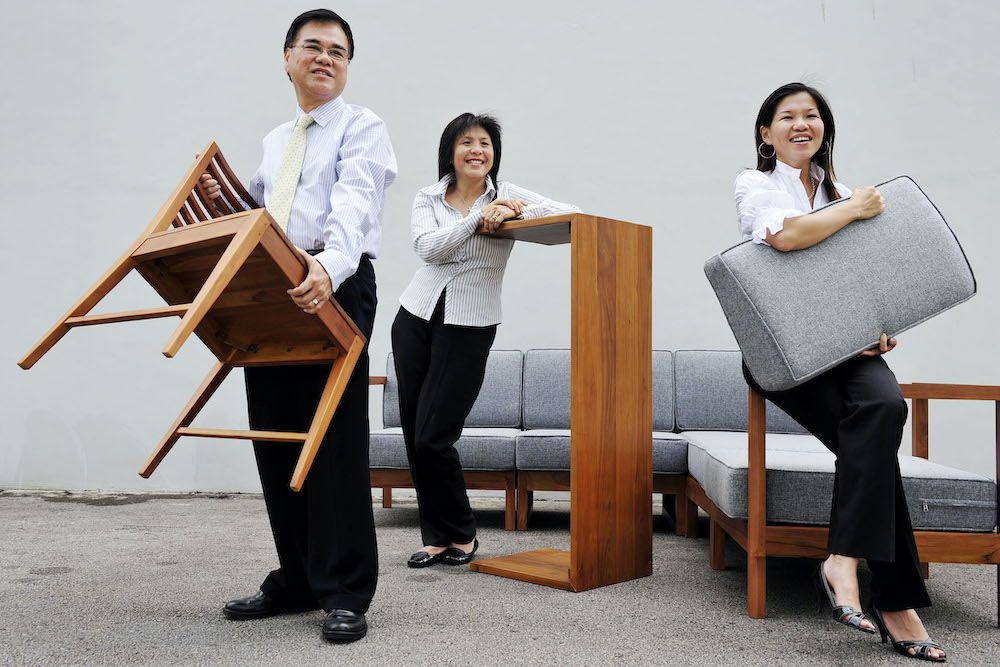
As the daughter of the company’s founder, Jamie’s journey into the business world was not without its challenges. Despite her qualifications, there were doubts and criticisms surrounding her involvement in the company.
Some questioned whether she was simply benefitting from her familial connections. However, Jamie quickly proved that being a second-generation leader was no easy task. The weight of the family legacy and the fear of letting down her father’s hard work pushed her to strive for excellence.
Jamie acknowledges that being the boss’s daughter came with higher expectations. Failure was not just a personal setback, but also a blow to the reputation and heritage of Scanteak. She knew that to truly establish herself, she had to be “extraordinary”, carving out her own identity while respecting the brand’s heritage.
Being the second-gen is actually much harder than being the first-gen. You have to prove yourself. As a first gen, if you fail, it’s okay, try again.
As a second gen, if you fail, it’s okay, try again — but you have shamed the legacy. You let down your father’s hard work. If you make it, good job; your dad gave you a solid foundation [to work with].
– Jamie Lim, CEO of Scanteak Singapore
One of the significant hurdles Jamie faced early on was gaining buy-in and trust from long-standing employees who had worked under her parents for decades.
As a young boss who didn’t fit the traditional corporate mould (complete with funky-coloured hair at the time), Jamie faced resistance and skepticism from some employees, who disregarded her ideas solely based on her status as the boss’s daughter.
However, Jamie learned to navigate these obstacles by being more transparent with her words and finding common ground with her team. She understood the value of their experience and opinions and recognised the need to respect their perspectives.
Instead of imposing changes, she initiated conversations and sought their input on improving the furniture and enhancing sales. By framing these discussions as collaborative efforts, Jamie was able to bridge the generational and experiential gaps, fostering a sense of unity and progress within the company.
In 2019, Jamie’s transition from a marketing role to the CEO position marked a significant milestone in her career. Notably, she shares a unique dynamic with her brother, who also holds a leadership role within the Group. Aware of their distinct leadership styles, their father astutely assigned them “individual sandboxes” within the business.
By delegating leadership responsibilities to each sibling, Jamie and her brother were able to flourish in their respective roles. Her brother has since assumed the CEO position at Nova Furnishings (a company that Scanteak most recently acquired), while Jamie took on the role of CEO at Scanteak Singapore. This division of responsibilities not only prevented potential conflicts, but also empowered each sibling to make independent decisions and contribute to the family’s business empire.
Today, Jamie’s parents remain involved in the business, with her father serving as the chairman of Scanteak Taiwan. They take on an advisory role, granting Jamie and her brother the autonomy to make their own decisions and shape the future of the company.
She acknowledges her father’s occasional disagreement with her ideas, but values his two cents and appreciates that he trusts her judgment.

On one occasion, Jamie and her father collaborated on a sofa design for its Jasen series. It proved to be highly popular, but they did not take the necessary steps to protect their intellectual property.
Consequently, the design was widely replicated and can now be found all over the Internet. Jamie passionately illustrates this point as she scrolls through a dedicated photo album titled ‘Copycat’ on her iPhone, exposing a multitude of copycat designs, some even imitating Scanteak’s distinctive logo and tagline.
Learning from this lesson, she explained that they took proactive measures with their Prologue collection by obtaining a design patent. “Prologue was patented because we really did a lot of R&D into how to make a piece of wood long and thin without breaking,” she said.

Launched in 2012, Prologue was primarily targeted at the Japanese market, and done in collaboration with acclaimed design studio Outofstock. Jamie initially questioned the hefty price tags associated with designer furniture, appreciating its aesthetic appeal, but acknowledging its inaccessibility for many consumers. This prompted Scanteak to introduce a designer range that offered a more affordable alternative.
Today, Prologue remains one of their best-sellers and has garnered numerous accolades, including the Singapore Good Design Award, IPOS Award for Design Innovation, Good Design Award in Japan, and the prestigious President’s Design Award. By safeguarding their creation through patent protection, Scanteak successfully shielded their design from replication by others.
Today, Scanteak’s trademark and patent portfolio stretches over into over 20 trademarks in 28 countries.
Jamie emphasised the importance for businesses to protect their creations, whether it be an invention, innovation, or brand. She candidly admitted that she initially failed to grasp this concept, but has since recognised its significance.
A footprint of 180 outlets worldwide
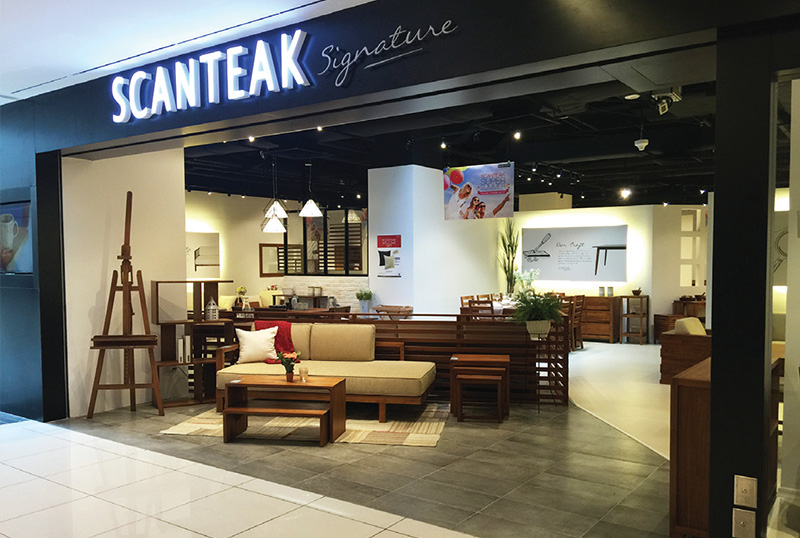
With a market presence in Singapore, Taiwan, and Japan, Scanteak operates around 180 stores globally. The majority of these stores, approximately 120, are located in Taiwan, demonstrating the brand’s popularity in the region.
While exact sales figures were not disclosed, Jamie mentioned that the Scanteak Group’s turnover is “north of US$100 million”, highlighting the company’s robust financial standing.
Scanteak’s growth strategy is focused on expanding its market reach within Southeast Asia, targeting countries like Malaysia, Indonesia, and Thailand. By prioritising markets that are within proximity and share language similarities, this strategic approach allows the company to capitalise on the “low-hanging fruits”, while laying the foundation for future expansion.
Reflecting on her business thus far, Jamie said that when she first joined Scanteak, Singapore had only three stores that were all “in the red”.
Through branding initiatives and achieving economies of scale, Scanteak managed to increase its outlet count to 15. However, the challenges of the COVID-19 pandemic forced some closures, reducing the total number to 11.
Nevertheless, the company’s turnover has grown significant since then, showcasing its resilience and adaptability.
As Scanteak looks to the future, the company envisions becoming the “LVMH (Louis Vuitton Moët Hennessy) of the home furnishings industry”. The focus lies not only on furnishing homes worldwide, but also on continuously evolving to meet changing customer needs.
Currently, Scanteak is venturing into the smart furniture realm. Instead of having customers select from existing designs at the store, Scanteak aims to enable any electrical furniture to become smart by simply plugging in a dongle.
With innovation as an important part of their business journey, Scanteak remains committed to growth and is actively seeking opportunities for further acquisitions.
When it comes to the valuable business advice Jamie received from her father, she emphasises the importance of working hard and working smart while maintaining flexibility and taking risks with integrity. Her father instilled the belief that success should not come at the expense of others or compromise ethical values and principles.
Furthermore, Jamie underscores the significance of staying faithful to small tasks. By excelling in even the smallest tasks and upholding integrity and values, success can be achieved and gradually build into a larger narrative.
With Jamie’s leadership and Scanteak’s unwavering commitment to quality and customer satisfaction, the brand continues to set new standards in the home furnishings industry, leaving a lasting legacy for generations to come.
Featured Image Credit: Scanteak
Also Read: Motherswork CEO on turning a failed maternity store into a retail empire in S’pore and China
This M’sian has made a biz out of letting wedding guests leave voicemails for the newlyweds
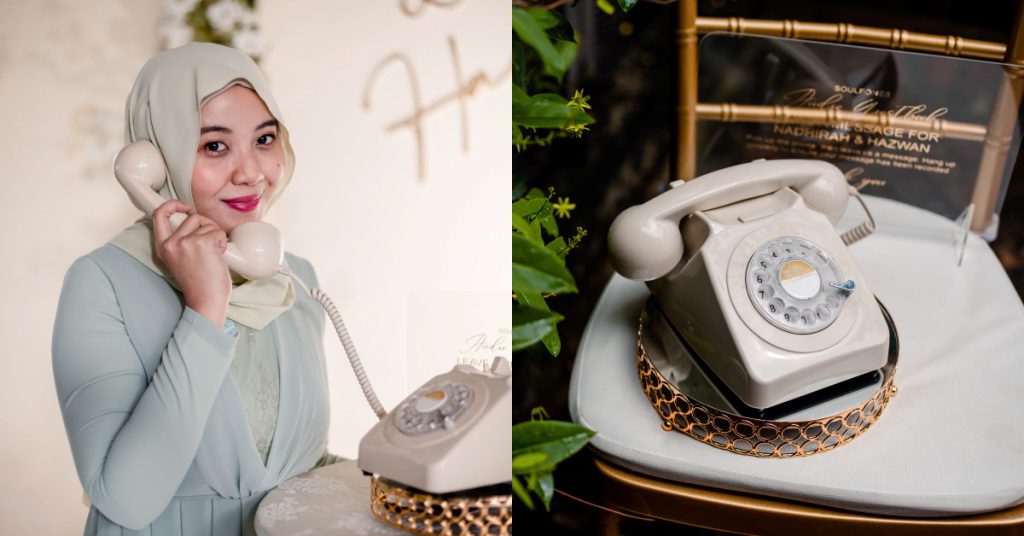
Nowadays, weddings can look and feel pretty identical as the type of food offered as well as the features it has such as photobooths are often replicated across the board.
However, we recently came across a service that wants to change things up, not with anything drastic or whimsical, but a rotary dial phone.
This is the brainchild of a local brand, Soulfones.
When an idea comes calling
Amirah, who is the founder of Soulfones, shared with us that for over five years, she has been involved in creating unforgettable experiences, coordinating seamless logistics, and bringing visions to life.
“My journey in the events industry began right after my own intimate wedding experience in 2017.”
She explained that, because she struggled to find a venue that could cater to intimate events, she was inspired to start her own intimate venue for other people who shared her vision.
This is when she launched her event space, ‘The Avenue’, in Cyberjaya.
“Since then, I have had the privilege of working on a diverse range of events, from beautiful intimate weddings to corporate functions and everything in between,” she added.

Through each experience, Amirah honed her skills in event planning, coordination, execution, and developed a deep understanding of what it takes to deliver exceptional results.
“With my blend of creativity, organisational prowess, a keen eye for detail, and an inspiration from international trends, Soulfones was born.”
Dialing it in
On the idea behind it all, Amirah expressed how she has always been captivated by the power of memories and the emotions they evoke.
Combined with her passion for technology and innovation, she envisioned a unique way of preserving and celebrating memories in a more modern and immersive manner.
She believes that traditional guestbooks, while timeless, often fail to capture the true essence of a moment or event.
Hence, she wanted to create a solution that would transcend the limitations of a written message and transport people back to those special occasions.

“By capturing their voices, laughter, and genuine emotions, we could unlock a whole new dimension of memory preservation and create a profound connection between the past and the present,” she added.
Amirah went on to assemble a team who aligned with her mission.
The team of six worked for nearly a year to develop a user-friendly and interactive platform that allows event hosts and their guests to capture and preserve their voices.
Soulfones launched in February 2023 and was marketed through TikTok and Instagram. “Since then, we’ve had multiple videos go viral which fully booked our Fones on most weekends for wedding events,” she stated.
The Fone is portable, meaning that users just have to set it up and connect the phone handle to the body, then connect it to the power bank provided by Soulfones.
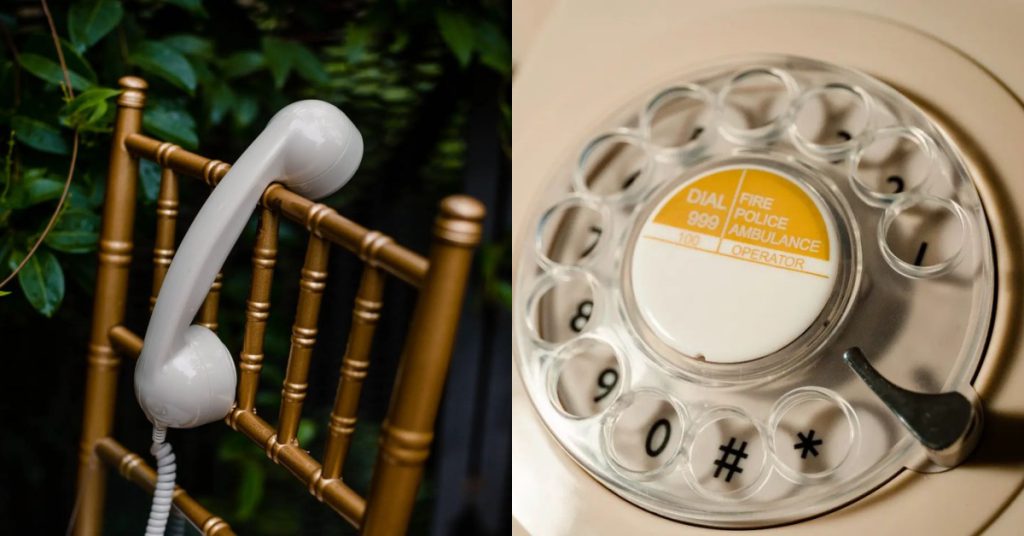
Once it is connected, guests simply have to lift the phone handle and wait till they hear the recorded greetings and a beep before recording their voice message.
Each voice message is saved as its own individual voicemail, and will be transferred and saved in Soulfones’ pendrive. The pendrive will be delivered to customers by mail within two to three weeks after the event date.
“We develop the technology ourselves and it is somewhat like a recording machine. Our customers can also customise their own greetings, so when their guests pick up the phone, they will hear their greetings first before leaving any messages making it more personal.”
Soulfones currently offers two types of packages for their audio guestbook. Package 1 costs RM499 whilst Package 2 costs RM549.

Both packages are for a five-day rental for an ivory-coloured Fone which lasts up to six to eight hours of usage, require pick-up and drop-off from Cyberjaya, and comes with an exclusive pendrive and box. Package 2 adds a custom A5 acrylic signage stand.
Picking up more calls
In regard to their plans for the future, Amirah shared that in the short term, they plan to launch their service in Singapore and Brunei after the countless inquiries they have had from people there.
Meanwhile, in the long term, Soulfones is hoping to expand their range of Fones to other colours and designs.

“With only a few months down the road, I am immensely proud of what we have achieved so far. We have witnessed the joy and emotional impact our audio guestbooks have had on countless individuals and families.”
Some may feel that the digital nature of Soulfones’ offering takes away the charm of having a physical memoir of a special moment like a wedding.
But for many others, convenience is king, and the ability to easily transport these memories through the cloud to wherever you go could be worth the switch.
Also Read: This M’sian brand has sustained itself with just one fizzy honey beverage for 6 years
Featured Image Credit: Soulfones
This M’sian hopped on the trend of painting weddings in real time to pioneer the art locally

“The dream was to do anything art-related, be financially stable, and to get eight hours of sleep daily,” Sophia Ng quipped during our interview.
As one of the pioneering artists to bring live wedding paintings to Malaysia, it’s safe to say that she’s fulfilled her first two wishes.

When the pandemic hit, the art studio Sophia was principal at couldn’t host classes anymore. So she decided to sign up for the Youth Art Entrepreneur Programme by the National Art Gallery.
There, she learnt the basics of running an art business over the course’s four months.
After completing it, she realised that she needed an art-related business model that would bring in constant flow of income.
That’s when she came across a viral TikTok video of a live wedding painter in the US, and experienced a lightbulb moment.
“I saw the potential in the business model and made it a mission to figure out how it could be done,” Sophia said.

Months were spent to work out the painting process, develop the equipment list, and build a portfolio to suit the local market.
To be more inclusive of different cultures, Sophia’s portfolio includes various samples to help clients of different backgrounds visualise the final painting.
“Most importantly, I had to practise again and again to ensure that I can complete the painting to a certain detail within a time frame. Because I can’t risk not finishing a live painting.”
Sophia also began documenting her journey on social media to gauge the local response to her business, and this became another form of market research. It even led to her first few bookings for live wedding paintings.
Setting her mind at ease(l)
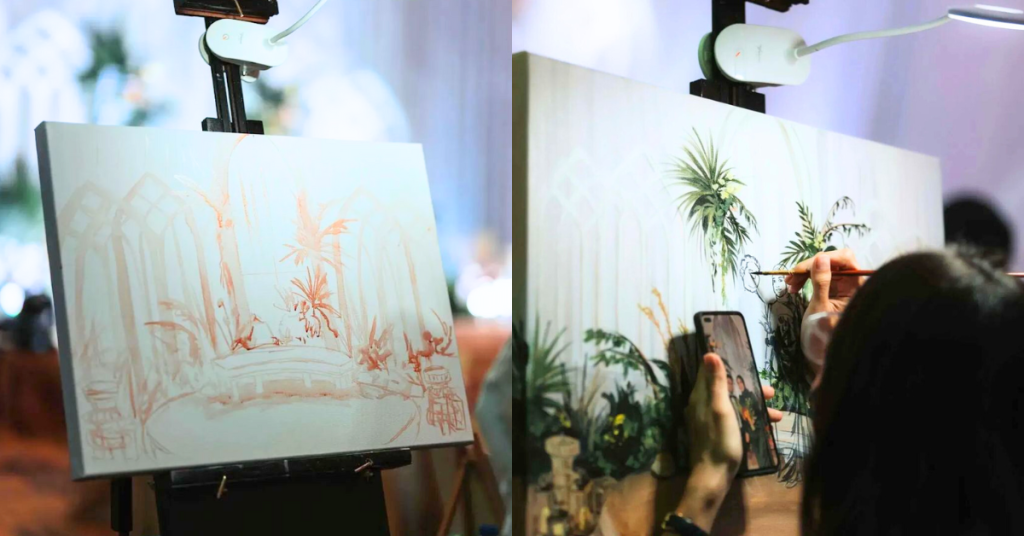
At the start of every live painting session, artists would typically paint the background. This could be the actual wedding setting or another backdrop that was agreed upon.
Sophia does this before guests arrive, which helps to ensure that nobody is blocking the view. It also puts her in the zone.
“It gives me a tunnel vision of the painting. I will remain focused on it until it’s complete despite the distractions,” she explained. Her past experiences as a teacher meant that she’s learnt to focus in any environment.
Then all that’s left to do is to wait for “the moment” that her clients have chosen to memorialise based on previous discussions.
This could be the march in, the vow exchange, the first dance, a cultural practice (like the tying of the mangalsutra, a pendant necklace, at Hindu weddings), or anything else the bride and groom favour.

The whole process takes around five to six hours and is presented to the happy couple before the end of the event.
“The gist of a live painting is that it captures a moment or an impression of the event as it happens. It seals a memory,” Sophia described.
“The focus of a regular portrait is the portrait itself, [and] the person painted is the main subject. Whereas in a live wedding painting, the moment is the main subject.”
This probably also explains why Sophia’s art style doesn’t really approach realism. Instead, it’s more impressionistic.
The painting will then be displayed for the rest of the event before being taken back to the studio for final touch ups, varnishing, and wiring. It’ll be ready for its new home within two weeks after the wedding event.

All that and “pen” some
Clients can also request to add family members who are no longer around into the painting, so that it’s as if they were actually present at the ceremony. All they have to do is provide photos for reference.
One of the most memorable sessions Sophia has had was to include a bride’s late mother, grandmother, and her two dogs who have passed.
“It was very moving for me as I understood the bride’s emotions. I was cared for by my grandmother in my early years and wasn’t able to have her on my wedding day. I also have six dogs that I love dearly.”
Overall, the addition of these family members took her around 10 hours to complete the painting.

Sophia’s live wedding painting service ranges from RM1,850 to RM2,850 depending on the portrait’s size.
Out of curiosity, we wondered if she’d faced any naysayers who questioned why they’d opt for a live painting over a wedding photographer, and Sophia said no.
She doesn’t think that the goal of live painters is to push out photographers either.
“I think we should co-exist. Live painting is a about capturing a moment, it’s also a form of live performance and an added element to the wedding event.”
Off to a flying (st)art

Sophia is currently based in KL, but her business can take her anywhere across the globe. Besides Malaysia, she’s also painted at wedding ceremonies in Thailand, Indonesia, and Singapore.
If she’s travelling to other Malaysian states or overseas though, she charges an additional travel fee.
As one of the first few (if not only) live wedding painting artists in Malaysia, her main goal is to continue bringing awareness to the art’s existence.
On top of sharing information online, she’s partnered with local wedding vendors like weddingsmalaysia, Bridepay, and Elysium Weddings. She also attends wedding industry related events, like exhibitions.

Based on the current global trend, the hype for live wedding paintings doesn’t seem to be dying down anytime soon.
But live wedding paintings have actually been around for centuries. They were quite popular at royal weddings, such as Queen Victoria’s.
With social media and wedding sites playing a helping hand in promoting the art as avant-garde, though, more everyday people will be able to enjoy this novel service on their special day.
So it seems that Sophia might just achieve what she’s wishing for.
- Learn more about Sophia Ng Studio here.
- Read other articles we’ve written about Malaysian startups here.
Also Read: When not cooking at a Michelin-starred spot, this M’sian is designing Japanese chef knives
Featured Image Credit: Sophia Ng Studio
Chicken rice and more: The story behind Malaysia’s halal Hainanese chicken rice giant
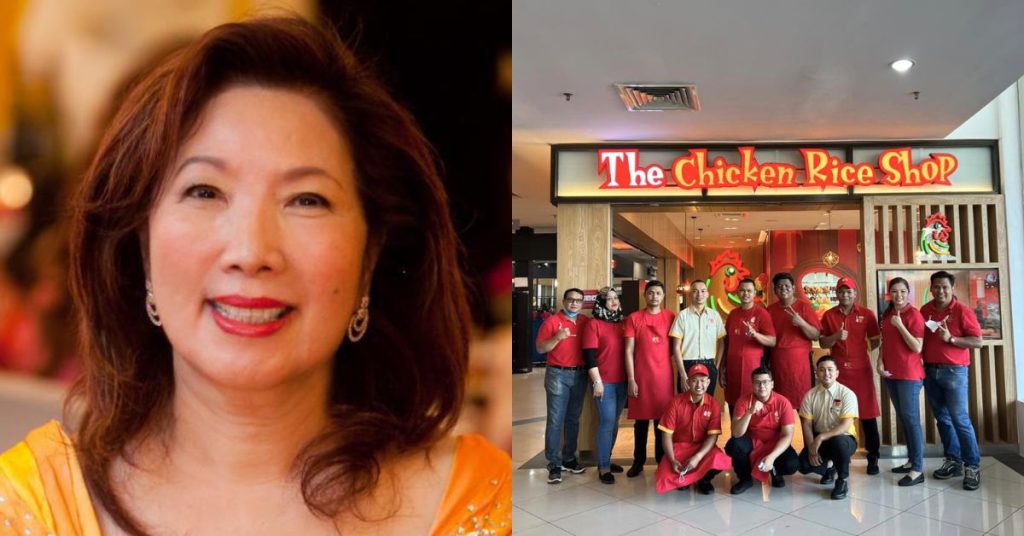
Is there any Malaysian who hasn’t heard the iconic The Chicken Rice Shop jingle?
Cue the bawk bawk bawks.
It’s one of the most recognisable homegrown F&B chains, but if you haven’t heard of it (or its earworm of a jingle), The Chicken Rice Shop serves up, you’ve guessed it, chicken rice.
What’s not to love? As the founder herself put it during a 2012 interview with BFM, “It’s halal, it’s wholesome, it’s balanced, and it’s chicken, which is universal.”
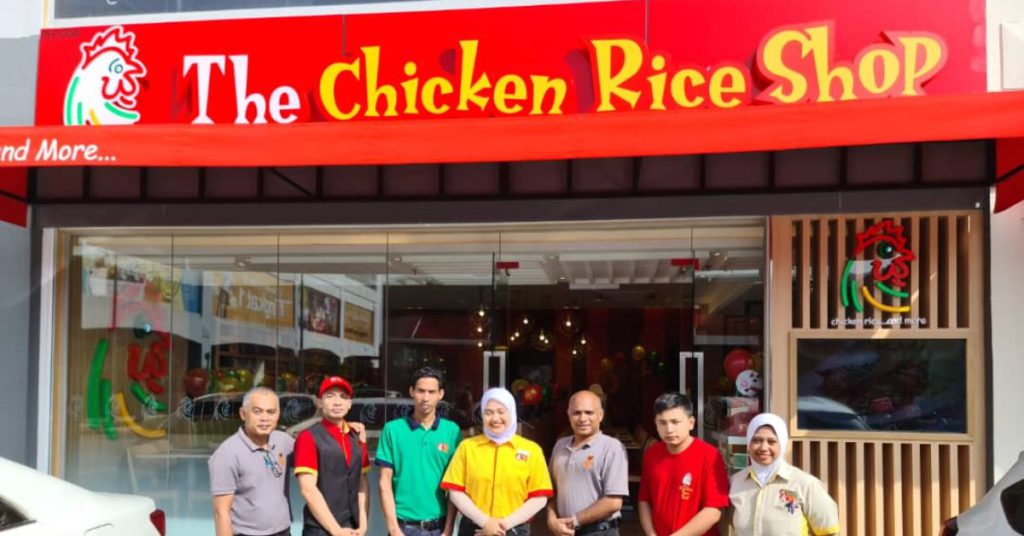
But surely, there’s more meat (pun intended) to the business’ story than that, right?
Especially after finding out that TCRS’ first store was opened in Taipan USJ, where our office is located, we knew we had to look further into what makes this chicken rice shop the chicken rice shop that many Malaysians know and love.
The mother-daughter duo behind it all
Before she was the founder of The Chicken Rice Shop (TCRS), Gaik Wong already had quite the experience with chickens. She had been the COO-cum-director of KFC Holdings (M) Bhd, working in the fast food industry for 25 years prior to starting TCRS, she told BFM.
She eventually retired from KFC Holdings, but that didn’t mean she retired from the scene.
Interestingly, it was Gaik’s daughter, Wong Kah Lin, who pushed her mum to start the new venture, she said in the BFM interview.
The two noticed an opportunity in the market for a fast food joint with an international concept, but serving localised dishes.

Seeing that Gaik’s mother-in-law is from Hainan and her own parents are from Penang, choosing to focus on chicken rice seemed like a natural progression.
With Gaik’s background in F&B and Kah Lin’s background in accounting, the two opened the first TCRS outlet in 2000.
Good business with good food
Like any good chicken rice stall, TCRS offers traditionally steamed chicken as well as crispy roasted chicken. Other than that, there are the honey barbecued and soy sauce chicken options, too.
Besides these signature chicken rice offerings, the chain also serves local favourites, including Hainanese curry chicken, Nyonya Pai Tee, Penang rojak, and more.
Yet, these dishes aren’t exactly hard to find. Heck, the core offering of chicken rice is one of the most easily found local delights. I’ll bet there’s a chicken rice seller in your vicinity right now.
Even Gaik herself said that “chicken rice is generic” to BFM.
So, considering that chicken rice is something available from places such as local kopitiams that sell the dish for much cheaper, what’s setting the brand apart from all the competition? Why choose TCRS over your neighbourhood hawker stall or warung?
This conundrum was something that was brought up during the BFM interview.

The mother-daughter duo continued to explain that it’s not so much about the dish itself, but rather, all the other value propositions TCRS gives.
Kah Lin further made her point by taking Western chains such as Mcdonald’s and KFC as examples.
To paraphrase her, fried chicken isn’t something novel or unique, and as much as KFC wants you to believe it, its fried chicken isn’t necessarily the best fried chicken in the world.
So, fried chicken is something common, and KFC’s dish might be seen as nothing special, so how have they built their brand to what it is today?
It’s all about the branding and positioning of the business and how it’s being operated.
Kah Lin had said, “I think where we position ourselves is we believe in having a family restaurant. It’s a place where everyone can get together and the kind of food that we serve actually caters to every age profile.”
In other words, TCRS is a place that you could bring both your kid and your grandma, and they would both likely enjoy the dishes.
As a chain, TCRS is also able to standardise their dishes and provide a reliable halal dining experience, something that’s key when it comes to expanding in Malaysia.
Staying savvy
“What is important in any business?” was a question that Gaik Wong had presented on the radio show.
She went on to answer, “You have to be innovative. Of course your core must still be there, your signature of chicken rice must still be there … A lot of companies fail because of a lack of innovation.”
Back in 2012, they used to innovate new dishes every few months. You might think those efforts have slowed down now, but TCRS actually still rolls out new dishes once in a while. Just recently, it introduced its ayam kilau and sambal hijau kilau offerings.

TCRS also has a loyalty app now, called SedapZ, to let users collect points and redeem rewards.
Chicken rice, and more
A couple of serial entrepreneurs, Kah Lin and Gaik’s TCRS Restaurants went on to create a number of other F&B chains that have also gained popularity over the years.
There’s DubuYo, founded in 2008. Originally known as Dubu Dubu, this chain serves up halal Korean food.
Established in 2011 is Sepiring. A return to our local flavours, it serves up dishes such as nasi kunyit with curry chicken, Ipoh hor fun, and—hey!—Hainanese chicken rice, too.
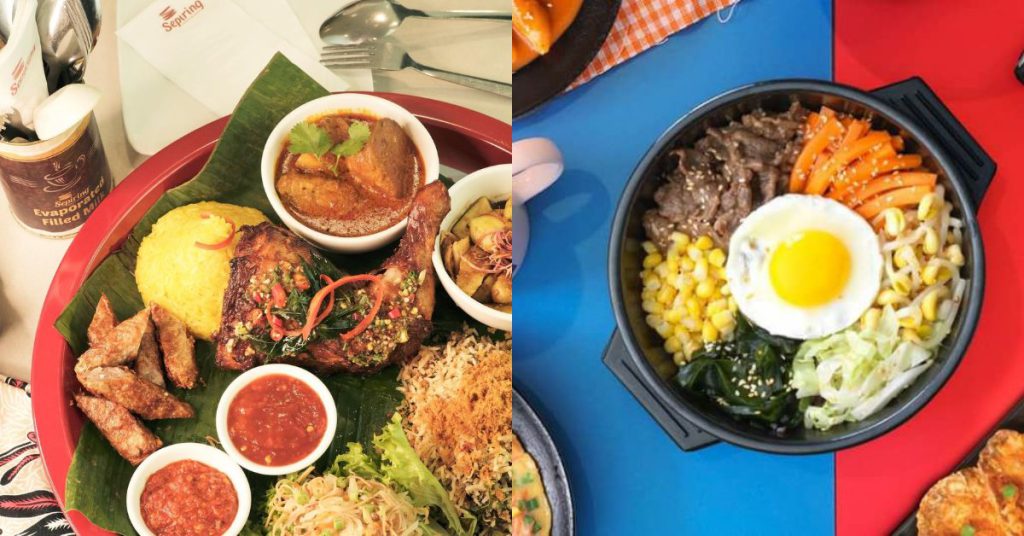
TCRS Restaurants was also operating another chain called Pancake House, which is a franchise from Manila. Sadly, the chain closed down in Malaysia in 2019.
Perhaps the true marker of a good business person is also knowing when it’s time to let go.
And, they also know when to exit.
In June 2019, The Chicken Rice Shop was reportedly acquired by Japanese F&B giant Zensho Holdings for RM220 million.
That’s why the SedapZ loyalty app also includes restaurants such as Sukiya and Ichiban Ramen, as both brands are under Zensho Holdings.
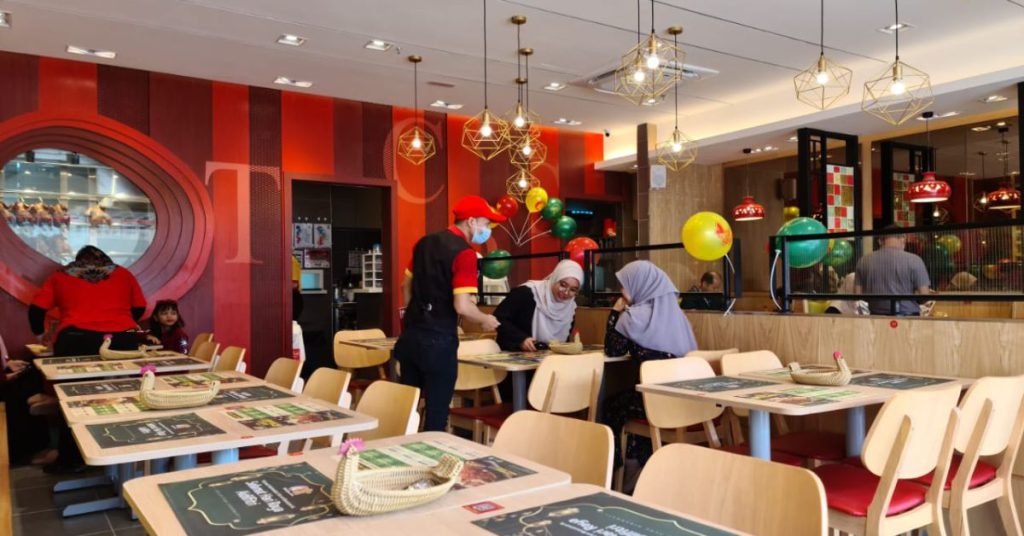
In Zensho Holdings’ report for the fiscal year ended March 31, 2022, it was reported that their fast food businesses had made around 150,673 million yen (around RM4,985,562,940). However, this also includes their other fast food chain, Hamazushi, which is a 100-yen sushi chain.
According to TCRS’ store locator, there appear to be 135 outlets of TCRS, bringing halal Hainanese chicken rice to Malaysians.
Looking back at the story and growth of TCRS, it’s fascinating to see how a business centred around the simple Hainanese chicken rice, which isn’t hard to come by, has come so far.
This is all thanks to Gaik and Kah Lin’s business-mindedness and wealth of industry knowledge, of course. The duo had already known they had a recipe for success when they opened the very first store in Taipan, USJ.
As Gaik said in an interview with The Edge in 2012, “If you want to get into business, you must do it big or don’t do it at all.”
Yet, is there now a space for newcomers to join in? Will The Chicken Rice Shop continue to be the go-to chicken rice shop?
With chains such as Chicken Rice Guys (also halal) cropping up, perhaps Malaysians are already looking for something new, but TCRS undoubtedly remains to be an iconic and prevalent source of “generic” chicken rice and a wholesome option in Malaysia.
- Learn more about The Chicken Rice Shop here.
- Read other articles about Malaysian F&B businesses here.
Also Read: Role-play as Friends characters & gossip over endless coffee at this coworking pop-up in KL
Featured Image Credit: Penang Women Entrepreneurs / The Chicken Rice Shop